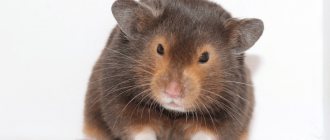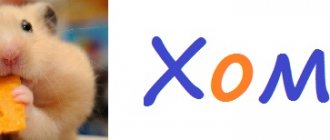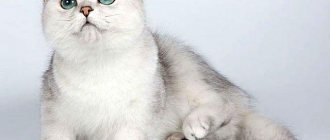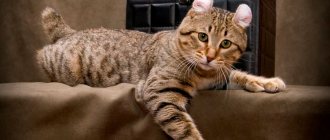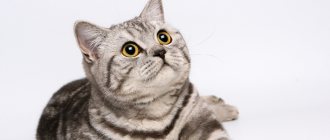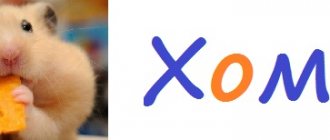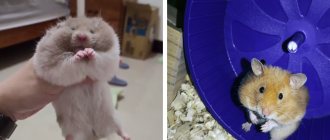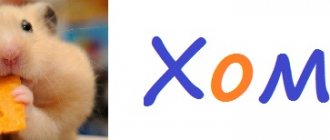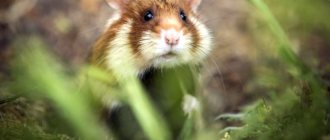A more correct name for this species is the Sungur hamster (Phodopus sungorus), but it was the name “Djungarian” that stuck, coming from the geographical region of China, from where these rodents were brought. They belong to the hamster family and, thanks to the vegetation on their legs, which completely covers their toes, to the genus Bryopods.
These animals can be distinguished by their pointed muzzle, protruding ears, and often by a characteristic stripe on their back.
These cute fluffies reach a maximum of 10 cm in length and are extremely friendly, playful pets, which is why they have become favorites of children. These animals can be distinguished by their pointed muzzle, protruding ears, and often by a characteristic stripe on their back. The tail is quite small in relation to the body, almost invisible, but the head against the background of the body is quite large , with large black (or red, in the case of some albinos) beady eyes, the body shape is round, weight varies from 30 to 65 g .
Dzungariki are very widespread in the southern part of Russian Siberia, Kazakhstan and Khakassia. Due to their habitat, dzhungariks have become popular in Russia. They can even be called the Russian hamster because they live in some of the arid regions of this country.
The white Djungarian hamster is no different from the rest of its relatives
Types of white hamsters
Djungarian and Syrian hamsters can be white. These two breeds are the most sought after representatives of the species, and as soon as you look at the representatives of both breeds, you will immediately understand how the Syrian hamster differs from the Djungarian.
They can be distinguished by size - Syrian ones, unlike their Dzungarian counterparts, reach an average of about 13-15, and sometimes 20 cm in length. Females tend to be larger and more prone to bouts of bad mood.
There are hamsters with a bad character, but for the most part Syrians have a good disposition and are quite good at making contact with people . But do not forget that each animal is an individual in its own way, and it is worth observing at least a little of its behavior and the behavior of its fellows before choosing and purchasing. Also, some Syrian hamsters have longer, fluffier fur. The color is mostly red, but there are others.
The size of Djungarian hamsters does not depend on gender, nor does their character. All representatives of this breed are quite friendly and, despite the scent glands visible to the naked eye, they practically do not emit an unpleasant odor. Aggressive individuals are almost never found, which is why Djungarians are bought as pets for children . This type of hamster is the easiest to train to handle, and they even enjoy being gently petted. Their coat, unlike the Syrians, is smooth and of medium length.
REFERENCE! Djungarian hamsters live on average 2-2.5 years, while their Syrian counterparts live 2.5-3.5.
In nature there is only a standard one, the rest are artificially bred
Life expectancy and illness
The health and lifespan of a hamster depend on heredity, living conditions, a balanced diet and the attentiveness of the owners. How long do Djungarian hamsters live? Under ideal conditions, a hamster can live up to four years. The average lifespan is two years.
Quite often, rodents receive mechanical injuries while walking. Hamsters do not have a sense of height, so they are able to jump from their hands even from very high heights, which can cause the animal to be seriously injured or die. Running wheels with a sparse grid or large mesh are dangerous. The animal's paw can get stuck while running, which can cause bruises and fractures.
Running balls are dangerous for hamsters. They can only serve as entertainment for the owner, but not for the animal itself. While running, the hamster constantly crashes into walls and various objects. In addition, while running in a ball, the hamster overheats, he lacks oxygen, which is why he may well get a heatstroke and die.
Other pets are no less dangerous for hamsters. If dogs are able to simply throw off the cage, then cats can reach the hamster with their claws through the bars. If there are cats at home, it is better to keep the hamster in a plastic container or a Dune-type cage that has solid plastic walls.
Due to their genetic proximity to Campbell's hamsters, many dwarf hamsters are predisposed to diabetes. The main symptom of the disease: the rodent drinks a lot of water often. You can check your suspicions using a test purchased at a regular human pharmacy.
Caring for a Djungarian hamster with diabetes differs only in its diet. The rodent should not be given any foods containing sugar. This is the only way the animal can live longer. The absence of a running wheel in the cage can lead to obesity, and then to heart and liver problems in the dwarf.
Djungaric colors:
- standard (represented by brown fur with a gray tint and a light belly)
- sapphire (gray back with a bluish tint and white or light gray belly)
- pearl (matte white wool, sometimes diluted with gray spaces)
- tangerine (similar to the Syrian, represented by a light red fur color with a cream tint)
In nature there is only the standard one, the rest are artificially bred. Albinos are rare among Djungarian hamsters. Djungarian hamsters are capable of changing color with the onset of cold weather in the wild.
However, even at home, if the air temperature remains around 16 degrees for several days, the color of their fur will change to lighter or even white, which is much less common. Naturally, this does not apply to initially white pets. Has your hamster changed its fur color?
Some animals change color not completely, but partially, in spots, which looks unique, exotic, very interesting and beautiful. For example: dark gray spots on a white coat with the same dark stripe on the back.
IMPORTANT! Many people are looking for a black dzhungarik, but this breed does not have this color. If you are offered a black hamster, it is most likely a Syrian or Campbell's hamster.
A little about the colors of Djungarian hamsters
Good day to all! My name is Masha and I really love animals. In this article I will tell you about the colors of Djungarian hamsters!
What they are and how they turn out, don’t close the tab and study with me!
And so, let's start with those colors that are most common and they are called single-gene colors
.
Why single-gene? Because there is only 1 gene in the gene code of these colors!
It's that simple, yes.
The very first color is standard
. His gene code is called AA. A standard hamster's eyes should be black.
The second color of Djungarian hamsters is sapphire
. His gene code is called dd. And he's recessive. The sapphire's eyes are also black.
The third color will be tangerine
. His gene code is called Mama. And it is dominant and lethal. The eyes are also black.
The fourth color of the Djungarian hamster is called yellow KG
. This color is considered a hybrid mutation. Its gene code is called pp. And he's recessive. This hamster has red eyes.
The fifth color is called brown
. This color is also considered a hybrid mutation. Its gene code is called mm. And he's recessive. The eyes are dark ruby color.
And the sixth color is called black
. This color is also considered a hybrid mutation. Its gene code is called aa. And he's recessive. The eyes are black.
INTERESTING TO KNOW:
A recessive gene is one that will not appear in the first generation, but will appear in the second and subsequent ones. A dominant gene is a gene that suppresses other genes in the first generation. Lethal gene - upon reaching sexual maturity, it can cause the death of an individual.
There are also two-gene, three-gene and four-gene combined colors. But I will tell you about them in the next article! And so as not to miss out, don’t forget to subscribe to us! We are trying to be better.
Source
White dwarfs - video
Whatever color you choose for your future pet, it is important to remember that any hamster needs appropriate care. Whether it is a white or brown hamster, everyone needs a spacious home, a house for daytime rest, timely change of bedding, and toys for physical activity, because hamsters are prone to obesity. With proper care, the animal will be healthy and its fur will be clean. And keep in mind that the Djungarian hamster is a nocturnal animal. During the day he sleeps, and towards evening he begins an active lifestyle.
Reproduction
Djungarian hamsters become sexually mature at four weeks of age. It is during this period that children of different sexes must be separated from each other. Early pregnancy is very dangerous for the female. Placing her with a male “so as not to get bored” is not the best idea. Constant pregnancies will quickly kill the female. It is almost impossible to sell cubs at a high price. Therefore, there is no point in risking the health of the animal.
The female is mated with the male at the age of 4 months. This age is considered optimal for the first pregnancy. After mating, the female and male should be seated, otherwise they can harm each other. Pregnancy lasts about 25 days. 1-11 babies are born. They are completely defenseless and dependent on their mother. Often, for some unknown reason, females abandon their babies or even eat them.
Only healthy adults with known pedigree should be bred. Due to the great external similarity of Djungarian hamsters to Campbell's hamsters, hybrid offspring are born quite often. Since Campbell's hamsters are prone to diabetes, they are able to pass this trait on to their offspring. That is why it is important to breed only purebred Djungarians.
What to feed a newborn hamster
After giving birth, the pet needs to be provided with comfortable conditions. Excessive anxiety can lead to the female refusing to feed her babies. Other family members and children should not have access to the nest with newborns.
The birthing process is quite energy-intensive; the female can lose up to 1/3 of her normal weight. It is recommended to support the hamster's body with a well-chosen, balanced diet. You can feed your postpartum hamster within 30 minutes after birth. During long labor, she can eat even in the intervals between the appearance of babies.
The postpartum diet must be increased by 100%, with the protein content in the diet being at least 20% and fat 10%. The menu is made up of grain mixtures and various additives:
- greenery;
- vegetables;
- fruits;
- berries.
The diet is supplemented with boiled eggs, cottage cheese and chicken meat. Provide the female with constant free access to fresh drinking water.
How they grow day by day
Every day in the life of Djungarian babies some event occurs that leads to their development. They grow stronger, increase in size, become covered with down, and then with wool. All this time caring for the children lies with the mother.
Pay attention to how long hamsters of different breeds live
How long do they grow after birth?
After birth, Djungarian hamsters begin to grow and develop rapidly.
The stages of development of Djungarian hamster babies are presented in the table:
| Life period of the dzhungarik, days | What's happening |
| 1–6 | They scurry around, almost don’t squeak if they’re hungry, don’t hear or see anything, in search of milk they rely on smell |
| 2–3 | Fluff grows, pigmentation appears |
| 6–7 | Ears open and start squeaking |
| 8–12 | They try food in the nest, feces, and crawl around the cage. |
| 12–16 | The eyes open, the increased weight does not allow the mother to return them to the nest as before |
| From the 15th | Able to wash themselves and climb over obstacles |
| 17–20 | They begin to run around in a wheel and may get injured when thrown out |
| 21–28 | The period of separation from the mother and brothers, the stage of the onset of aggression in the mother, the onset of puberty, the possibility of early pregnancy |
| From the 28th | You can give fruit |
| 42–56 | Ready to get a new owner and move to another house |
| From 56th | Fights for territory |
Hamsters grow actively for up to 2–3 months, and within another 2 months they can grow stronger and acquire adult weight.
When they open their eyes
Around the end of the second week of life, babies' eyelids begin to lift. At first a barely noticeable gap appears. At the beginning of the 3rd week, the eyes are already fully open. From now on, you need to make sure that the hamsters sleep in a warm nest, and move them there if they fall asleep in another place.
